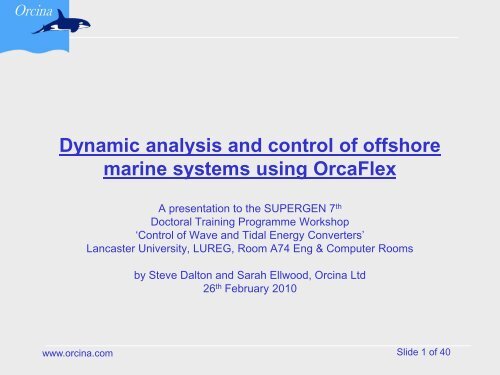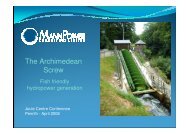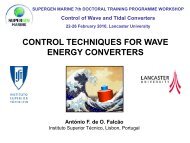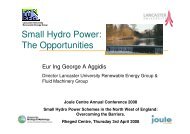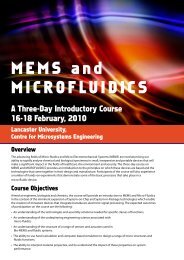OrcaFlex - Engineering Department
OrcaFlex - Engineering Department
OrcaFlex - Engineering Department
You also want an ePaper? Increase the reach of your titles
YUMPU automatically turns print PDFs into web optimized ePapers that Google loves.
Dynamic analysis and control of offshore<br />
marine systems using <strong>OrcaFlex</strong><br />
A presentation to the SUPERGEN 7 th<br />
Doctoral Training Programme Workshop<br />
‘Control of Wave and Tidal Energy Converters’<br />
Lancaster University, LUREG, Room A74 Eng & Computer Rooms<br />
by Steve Dalton and Sarah Ellwood, Orcina Ltd<br />
26 th February 2010<br />
www.orcina.com Slide 1 of 40
<strong>OrcaFlex</strong><br />
(latest release v9.3, Aug-09)<br />
Contents<br />
1. About <strong>OrcaFlex</strong> - Overview<br />
2. Capabilities for modelling offshore marine systems<br />
1. Companies using <strong>OrcaFlex</strong> to analyse marine RE systems<br />
2. Types of marine energy systems modeled<br />
3. Environmental modeling – waves, current etc<br />
4. Example models<br />
3. Current Problems and Some Solutions<br />
4. How <strong>OrcaFlex</strong> can support SUPERGEN2 Marine<br />
Consortium and other RTD into Marine Systems<br />
5. Way Forward<br />
www.orcina.com Slide 2 of 40
<strong>OrcaFlex</strong><br />
(latest release v9.3, Aug-09)<br />
1. About <strong>OrcaFlex</strong><br />
Our main product <strong>OrcaFlex</strong> is the world's leading<br />
software package for the design and analysis of a<br />
wide range of marine systems, including all types of:<br />
– Riser systems: SCRs, TTRs, hybrids, flexibles, umbilicals,<br />
hoses, bend stiffeners, bend restrictors etc.<br />
– Mooring systems: spread, turret, SPM, jetty, etc.<br />
– Installation planning with capabilities across the full range of<br />
scenarios.<br />
– Towed systems: bundle dynamics, seismic arrays, towed<br />
bodies, etc.<br />
– Defence, marine renewables, seabed stability and many<br />
other types of system.<br />
www.orcina.com Slide 3 of 40
<strong>OrcaFlex</strong>- Visualisation<br />
The GUI, visualisation and<br />
automation facilities of<br />
<strong>OrcaFlex</strong> are widely<br />
recognised as best-in-class,<br />
making <strong>OrcaFlex</strong> the most<br />
productive line dynamics<br />
environment to work with.<br />
<strong>OrcaFlex</strong><br />
(latest release v9.3, Aug-09)<br />
www.orcina.com Slide 4 of 40
<strong>OrcaFlex</strong><br />
(latest release v9.3, Aug-09)<br />
2. Capabilities for analysing Offshore<br />
Marine RE Systems<br />
• Analysing the static and dynamic response of structures to simple to<br />
complex environments<br />
• Can import hydrodynamic data from diffraction (AQWA, WAMIT)<br />
• Modelling structures – vessels (RAOs/ QTFs), buoys, shapes, links,<br />
winches, lines (pipe chain & rope, wire moorings, umbilicals, risers)<br />
• 3D and 6D Buoys, Surface piercing, CALM, SPAR, Towed fish, wings.<br />
• Modelling the environment - seabed, sea, current, wind, waves<br />
• Full non-linear capabilities (material, geometric, loading regime,<br />
boundary conditions, friction, contact, release, buckling etc)<br />
• Modal analyses of lines (natural frequencies and mode shapes)<br />
• Time history and detailed fatigue analysis (regular & rainflow) options<br />
• Both Implicit and Explicit solvers are provided to solve most problems<br />
www.orcina.com Slide 5 of 40
<strong>OrcaFlex</strong><br />
(latest release v9.3, Aug-09)<br />
2.1 Companies and Academia using <strong>OrcaFlex</strong><br />
to analyse marine RE systems<br />
• Some of our Clients that use <strong>OrcaFlex</strong> for the design<br />
and analysis of Marine Renewable Systems include:-<br />
– AWS Ocean<br />
– Aquamarine<br />
– Nemo <strong>Engineering</strong><br />
– OceanLinx<br />
– Ocean Power Technologies<br />
– Pelamis Wave (formerly OPD)<br />
– Trelleborg (formerly CRP)<br />
– Wavegen<br />
– Several Universities (SuperGen Marine Programme)<br />
Edinburgh. University of Strathclyde , Herriot Watt.<br />
www.orcina.com Slide 6 of 40
<strong>OrcaFlex</strong><br />
(latest release v9.3, Aug-09)<br />
2.2 Types of marine energy systems modelled<br />
• Marine Renewable Devices include:-<br />
– Wave Energy Converters (WECs)<br />
– Energy harvesting Vehicles (e.g. Wave Glider, Wave Runner,<br />
SeaRaser)<br />
– Tidal Energy Converters (TECs)<br />
• Types of WEC devices include:-<br />
– BMD-Buoyant Moored device<br />
– HCD-Hinged Contour device<br />
– OWC-Oscillating Water Column<br />
• Types of TEC devices include:-<br />
– Tidal Stream Systems normally using Horizontal or Vertical axis<br />
devices. Others include oscillating (hydrofoils) or Venturi effects<br />
– Barrages making use of head (potential energy)<br />
– Tidal Lagoons (making use of potential and kinetic energy of tides)<br />
www.orcina.com Slide 7 of 40
<strong>OrcaFlex</strong><br />
(latest release v9.3, Aug-09)<br />
• Current Technologies<br />
Attenuators and Point Absorbers:-<br />
- BMD-Buoyant Moored Device. e.g. wavebob,<br />
wavehub, PowerBuoy (OPT), wave<br />
energy point absorber (OSU PMLG)<br />
- HCD-Hinged Contour Device .<br />
e.g. Pelamis, Waveroller<br />
(OPD), WRASPA, Oyster, AWS.<br />
- Heave, Pitch & Surge devices<br />
OWC-Oscillating Water Column:- e.g.<br />
Oceanlinx, Wavedragon, Orecon,<br />
Limpet, Wavegen Near-shore<br />
Overtopping devices e.g. (wavedragon)<br />
Submerged differential pressure –<br />
normally hydraulic<br />
Other types – e.g. wave rotor and flexible<br />
structures (shape/volume)<br />
Main Types of WECs<br />
www.orcina.com Slide 8 of 40
<strong>OrcaFlex</strong><br />
(latest release v9.3, Aug-09)<br />
2.3 Wave Resource in UK waters<br />
• The world ocean resource is<br />
massive (Scotland alone is 60GW)<br />
• Many studies carried out e.g Fugro<br />
OCEANOR, Orecon, APBmer (UK<br />
Marine RE Atlas), DTI, ETSU.<br />
• Significant work already done<br />
under SuperGen programme<br />
The physical consequences of<br />
energy extraction on marine<br />
resources are now much more<br />
quantifiable and resource<br />
assessment before and after<br />
device deployment can now be<br />
more effectively conducted,<br />
based upon firm scientific<br />
principles.<br />
www.orcina.com Slide 9 of 40
<strong>OrcaFlex</strong><br />
(latest release v9.3, Aug-09)<br />
Properties and Types of waves<br />
www.orcina.com Slide 10 of 40
Spectral Density (m^2 / Hz)<br />
Spectral Density (m^2 / Hz)<br />
<strong>OrcaFlex</strong><br />
(latest release v9.3, Aug-09)<br />
Modelling Waves in <strong>OrcaFlex</strong><br />
Regular Waves (Hs & Tz)<br />
• Airy<br />
• Dean<br />
• Stokes 5 th<br />
• Cnoidal<br />
Irregular (Random) Waves<br />
Setting up a random sea-state<br />
• JONSWAP and ISSC Spectra,<br />
• Ochi-Hubble Spectrum,<br />
• Torsethaugen Spectrum,<br />
• Gaussian Swell,<br />
<strong>OrcaFlex</strong> 9.4a22: pretty Ochi.dat (modified 14:19 on 05/02/2010 by <strong>OrcaFlex</strong> 9.4a22)<br />
Spectral Density for Wave Train 'Wave1'<br />
40<br />
30<br />
20<br />
10<br />
<strong>OrcaFlex</strong> 9.4a22: default Jonsw ap.dat (modified 14:18 on 05/02/2010 by <strong>OrcaFlex</strong> 9.4a22)<br />
Spectral Density for Wave Train 'Wave1'<br />
140<br />
120<br />
100<br />
80<br />
60<br />
40<br />
20<br />
• User-Defined Spectrum.<br />
0<br />
0<br />
0.1<br />
0.2<br />
0.3<br />
0.4<br />
Frequency (Hz)<br />
0.5<br />
0.6<br />
0.7<br />
0<br />
0<br />
0.05<br />
0.1<br />
0.15<br />
Frequency (Hz)<br />
0.2<br />
0.25<br />
www.orcina.com Slide 11 of 40
<strong>OrcaFlex</strong><br />
(latest release v9.3, Aug-09)<br />
Wave Power Formula<br />
• In deep water where the water depth is larger than half the<br />
wavelength, the wave energy flux is<br />
• where<br />
– P the wave energy flux per unit wave crest length (kW/m);<br />
– H m0 is the significant wave height (meter), as measured by wave buoys and<br />
predicted by wave forecast models. By definition, H m0 is four times the<br />
standard deviation of the water surface elevation;<br />
– T e is the energy period (second);<br />
– ρ is the mass density of the water (kg/m 3 ), and<br />
– g is the acceleration by gravity (m/s 2 ).<br />
• The above formula states that wave power is proportional to the<br />
wave period and to the square of the wave height. When the<br />
significant wave height is given in meters, and the wave period<br />
in seconds, the result is the wave power in kilowatts (kW) per<br />
meter of wavefront length<br />
www.orcina.com Slide 12 of 40
<strong>OrcaFlex</strong><br />
(latest release v9.3, Aug-09)<br />
Wave Power Calculation - example<br />
• Example: Consider moderate ocean swells, in deep water, a few<br />
kilometers off a coastline, with a wave height of 3 meters and a<br />
wave period of 8 seconds. Using the formula to solve for power,<br />
we get<br />
-<br />
• meaning there are 36 kilowatts of power potential per meter of<br />
coastline.<br />
• In major storms, the largest waves offshore are about 15 meters<br />
high and have a period of about 15 to 20 seconds. According to<br />
the above formula, such waves carry about 1.7 MW/m of power<br />
across each meter of wavefront and can be very destructive.<br />
• An effective wave power device captures as much as possible<br />
of the wave energy flux. As a result the waves will be of lower<br />
height in the region behind the wave power device.<br />
www.orcina.com Slide 13 of 40
<strong>OrcaFlex</strong><br />
(latest release v9.3, Aug-09)<br />
Wave energy and wave energy flux<br />
• In a sea state, the average energy density per unit area of gravity waves on the<br />
water surface is proportional to the wave height squared, according to linear<br />
wave theory:<br />
–<br />
• where E is the mean wave energy density per unit horizontal area (J/m 2 ), the<br />
sum of kinetic and potential energy density per unit horizontal area. PE=KE both<br />
contributing half to the wave energy density E, as can be expected from the<br />
equipartition theorem.<br />
• As the waves propagate, their energy is transported. The energy transport<br />
velocity is the group velocity. As a result, the wave energy flux, through a<br />
vertical plane of unit width perpendicular to the wave propagation direction, is<br />
equal to:-<br />
• with cg the group velocity (m/s). Due to the dispersion relation for water waves<br />
under the action of gravity, the group velocity depends on the wavelength λ, or<br />
equivalently, on the wave period T. Further, the dispersion relation is a function<br />
of the water depth h. As a result, the group velocity behaves differently in the<br />
limits of deep and shallow water, and at intermediate depths.<br />
www.orcina.com Slide 14 of 40
<strong>OrcaFlex</strong><br />
(latest release v9.3, Aug-09)<br />
Some WECs being designed, developed and/ or tested<br />
www.orcina.com Slide 15 of 40
Wave Energy Converters (WECs)<br />
<strong>OrcaFlex</strong><br />
(latest release v9.3, Aug-09)<br />
• Over 80 companies globally developing different types of wave energy devices (see EMEC).<br />
• A number of wave energy devices have been built but few have yet been developed up into<br />
commercial scale WECs because this of the very challenging environment & technicalities.<br />
• A few devices have been built and tested at large scale and at least three types have been grid<br />
connected (Wavedragon, Pelamis, Oyster). These are still being optimised.<br />
• Most have not been fully successful due to cost, complexity, reliability and harsh environment<br />
• Major UK companies include the following covering the three main types of WEC device:-<br />
– Aquamarine (Oyster-HCD/OWC)<br />
– AWS Ocean (AWS-III-BMD)<br />
– Carnegie Corporation (CETO-BMD))<br />
– Finavera Renewables (AquaBuoy and Wave Buoy-BMD)<br />
– Manchester Bobber (BMD)<br />
– OceanLInx (OWC)<br />
– OPT (Power Buoy-BMD) –Consortium with Japan<br />
– Pelamis wave, formerly OPD (Pelamis-HCD)<br />
– Protean Power (BMD)<br />
– Trident Energy (BMD)<br />
– WaveBob (BMD))<br />
– Wave Dragon (floating slack moored OWC).<br />
www.orcina.com Slide 16 of 40
Power take-off 1-2 Length (m)<br />
Power take-off 1-2 Tension (kN)<br />
<strong>OrcaFlex</strong><br />
(latest release v9.3, Aug-09)<br />
Example 3: Simulation of Cockerell raft<br />
<strong>OrcaFlex</strong> 9.4a24: Cockerell raft.sim (modified 11:55 on 06/07/2004 by <strong>OrcaFlex</strong> 8.5a)<br />
Time History: Pow er take-off 1-2 Length<br />
12<br />
11.5<br />
11<br />
10.5<br />
10<br />
9.5<br />
-5<br />
0<br />
5<br />
Time (s)<br />
10<br />
15<br />
20<br />
<strong>OrcaFlex</strong> 9.4a24: Cockerell raft.sim (modified 11:55 on 06/07/2004 by <strong>OrcaFlex</strong> 8.5a)<br />
Time History: Pow er take-off 1-2 Tension<br />
150<br />
100<br />
50<br />
0<br />
-50<br />
-100<br />
-150<br />
-5<br />
0<br />
5<br />
Time (s)<br />
10<br />
15<br />
20<br />
www.orcina.com Slide 17 of 40
Bow line 1 Effective Tension (kN) at End A<br />
Float 1 Moment (kN.m)<br />
Float 1 Velocity (m/s)<br />
<strong>OrcaFlex</strong><br />
(latest release v9.3, Aug-09)<br />
Example 5: Operations on Articulated Jetty<br />
<strong>OrcaFlex</strong> 9.4a20: articulated jetty - RMI version.dat (modified 00:28 on 05/10/2001 by <strong>OrcaFlex</strong> 7.5a34)<br />
Time History: Float 1 Moment<br />
40000<br />
35000<br />
30000<br />
25000<br />
20000<br />
15000<br />
10000<br />
5000<br />
0<br />
-10<br />
0<br />
10<br />
Time (s)<br />
20<br />
30<br />
<strong>OrcaFlex</strong> 9.4a20: articulated jetty - RMI version.dat (modified 00:28 on 05/10/2001 by <strong>OrcaFlex</strong> 7.5a34)<br />
Time History: Bow line 1 Effective Tension at End A<br />
30<br />
<strong>OrcaFlex</strong> 9.4a20: articulated jetty - RMI version.dat (modified 00:28 on 05/10/2001 by <strong>OrcaFlex</strong> 7.5a34)<br />
Time History: Float 1 Velocity<br />
2.5<br />
20<br />
2<br />
10<br />
1.5<br />
0<br />
1<br />
-10<br />
0.5<br />
-20<br />
-10<br />
0<br />
10<br />
Time (s)<br />
20<br />
30<br />
0<br />
-10<br />
0<br />
10<br />
Time (s)<br />
20<br />
30<br />
www.orcina.com Slide 18 of 40
Bow mooring Effective Tension (kN) at End B<br />
Link 1X Tension (kN)<br />
Example 6: Fish Model links<br />
<strong>OrcaFlex</strong><br />
(latest release v9.3, Aug-09)<br />
<strong>OrcaFlex</strong> 9.4a24: Fish model links.sim (modified 14:27 on 05/11/2007 by <strong>OrcaFlex</strong> 9.1a) (azimuth=270; elevation=0)<br />
Time: 20.0000s<br />
5 m<br />
Z<br />
X<br />
<strong>OrcaFlex</strong> 9.4a24: Fish model links.sim (modified 14:27 on 05/11/2007 by <strong>OrcaFlex</strong> 9.1a)<br />
Time History: Bow mooring Effective Tension at End B<br />
1<br />
0.95<br />
0.9<br />
Z<br />
X<br />
0.85<br />
0.8<br />
0.75<br />
0.7<br />
0.65<br />
-5<br />
0<br />
5<br />
Time (s)<br />
10<br />
15<br />
20<br />
<strong>OrcaFlex</strong> 9.4a24: Fish model links.sim (modified 14:27 on 05/11/2007 by <strong>OrcaFlex</strong> 9.1a)<br />
Time History: Link 1X Tension<br />
20<br />
15<br />
10<br />
5<br />
0<br />
-5<br />
-10<br />
-5<br />
0<br />
5<br />
Time (s)<br />
10<br />
15<br />
20<br />
www.orcina.com Slide 19 of 40
Horizontal distance in metres<br />
Axial load in tethers in kN<br />
<strong>OrcaFlex</strong><br />
(latest release v9.3, Aug-09)<br />
Example 8: Simulation of Wave Glider UUV –<br />
wave powered device - Liquid Robotics Inc<br />
Distance covered by Wave Glider (model-9b)<br />
90<br />
80<br />
70<br />
60<br />
50<br />
40<br />
glider<br />
30<br />
20<br />
10<br />
0<br />
0 10 20 30 40 50 60<br />
Time in seconds<br />
Axial loads in tethers of Wave Glider (model-9b)<br />
0.5<br />
0.4<br />
0.3<br />
0.2<br />
0.1<br />
0<br />
0 10 20 30 40 50 60<br />
-0.1<br />
glider<br />
-0.2<br />
-0.3<br />
-0.4<br />
-0.5<br />
Time in seconds<br />
www.orcina.com Slide 20 of 40
<strong>OrcaFlex</strong><br />
(latest release v9.3, Aug-09)<br />
Wave Runner -A new propulsion system for<br />
boats ditches the diesel?<br />
Wave-powered boat finishes crossing<br />
• A Japanese adventurer has completed a<br />
three-month journey from Hawaii to<br />
Japan in a boat powered by the energy of<br />
ocean waves.<br />
The 4,800-mile voyage, which began in<br />
Honolulu in March, ended when Kenichi<br />
Horie's three-ton yacht docked in<br />
Wakayama in western Japan last night.<br />
"The sea was so calm, and the weather<br />
was so great throughout my journey.<br />
That's why it took me so long," he said.<br />
His boat, which relies on wave energy to<br />
move two fins at its bow and propel it<br />
forward, sailed at an average speed of<br />
1.5 knots - slower than humans walk.<br />
www.orcina.com Slide 21 of 40
<strong>OrcaFlex</strong><br />
(latest release v9.3, Aug-09)<br />
Tidal Resource in UK waters<br />
The key advantages of tidal<br />
Stream energy over other<br />
renewable forms of generation<br />
are:<br />
• High energy intensity smaller<br />
cheaper rotors for a given<br />
power<br />
• Predictable energy capture less<br />
project risk<br />
• Energy to a timetable greater<br />
revenue per MWh generated<br />
• Low environmental impact low<br />
development overheads<br />
• Simple decommissioning low<br />
back-end risk and cost<br />
www.orcina.com Slide 22 of 40
<strong>OrcaFlex</strong><br />
(latest release v9.3, Aug-09)<br />
Main Types of TECs<br />
• Current Technologies<br />
– HAD-Horizontal Axis Device.<br />
e.g. MCT, Open hydro, Torcado.<br />
– VAD-Vertical Axis Device.<br />
e.g.Kobold by pontediarchemede<br />
– Oscillating Hydrofoil Devices<br />
e.g. Pulse Tidal - Reduces water<br />
depth & size limitations over HAD<br />
– Venturi Effect<br />
– Other Designs<br />
– Barrage and Lagoons<br />
Using existing low head water<br />
turbine technology (Kaplan's) into<br />
large fixed, gravity of floating<br />
structures to generate electricity.<br />
www.orcina.com Slide 23 of 40
<strong>OrcaFlex</strong><br />
(latest release v9.3, Aug-09)<br />
Methods to secure TECs to the seabed<br />
There are several methods to securing TEC to the seabed (as defined on EMEC website):<br />
i) Seabed Mounted / Gravity Base:<br />
This is physically attached to the seabed or is fixed by virtue of its massive weight. In some cases there<br />
may be additional fixing to the seabed.<br />
ii) Pile Mounted:<br />
This principle is analogous to that used to mount most large wind turbines, whereby the device is attached<br />
to a pole penetrating the ocean floor. Horizontal axis devices will often be able to yaw about this structure.<br />
This may also allow the turbine to be raised above the water level for maintenance.<br />
iii) Floating:<br />
Flexible mooring: The device is tethered via a cable/chain to the seabed, allowing considerable freedom<br />
of movement. This allows a device to swing as the tidal current direction changes with the tide.<br />
Rigid mooring:<br />
The device is secured into position using a fixed mooring system, allowing minimal leeway.<br />
Floating structure:<br />
This allows several turbines to be mounted to a single platform, which can move in relation to changes in<br />
sea level.<br />
iv) Hydrofoil Inducing Downforce:<br />
This device uses a number of hydrofoils mounted on a frame to induce a downforce from the tidal current<br />
flow. Provided that the ratio of surface areas is such that the downforce generated exceeds the overturning<br />
moment, then the device will remain in position.<br />
ORCAFLEX can model most of these in simple up to complex sea states<br />
www.orcina.com Slide 24 of 40
Z (m)<br />
<strong>OrcaFlex</strong><br />
(latest release v9.3, Aug-09)<br />
Modelling Currents & Tides in <strong>OrcaFlex</strong><br />
1. Multiple sets of current profiles can<br />
be used, e.g. for 100yr, 1yr and<br />
95% exceedance<br />
<strong>OrcaFlex</strong> 9.3c (azimuth=220; elevation=5)<br />
20 m<br />
Y<br />
Z<br />
X<br />
2. Current can be ramped during<br />
statics build-up<br />
3. Vertical current variation by<br />
Interpolation or power law<br />
4. Tide cycles modelled if important<br />
No Depth (m)<br />
factor Rot (deg)<br />
<strong>OrcaFlex</strong> 9.3c<br />
Vertical Current Profile<br />
0<br />
1 0 1 0<br />
-20<br />
2 20 0.8 10<br />
3 30 0.6 30<br />
-40<br />
4 55 0.4 -5<br />
-60<br />
5 85 0.3 40<br />
-80<br />
6 100 0.25 35<br />
-100<br />
0<br />
0.2<br />
0.4<br />
Speed (m/s)<br />
0.6<br />
0.8<br />
1<br />
www.orcina.com Slide 25 of 40
Properties of Tides and Currents<br />
<strong>OrcaFlex</strong><br />
(latest release v9.3, Aug-09)<br />
Energy calculations<br />
• Various turbine designs have varying efficiencies and therefore varying<br />
power output. If the efficiency of the turbine "ξ" is known the equation<br />
below can be used to determine the power output.<br />
• The energy available from these kinetic systems can be expressed as:<br />
• where:<br />
– ξ = the turbine efficiency<br />
– P = the power generated (in watts)<br />
– ρ = the density of the water (seawater is 1025 kg/m³)<br />
– A = the sweep area of the turbine (in m²)<br />
– V = the velocity of the flow<br />
• Relative to an open turbine in free stream, depending on the geometry<br />
of the shroud shrouded turbines are capable of as much as 3 to 4 times<br />
the power of the same turbine rotor in open flow. .[36]<br />
www.orcina.com Slide 26 of 40
Tidal Energy Converters (TECs)<br />
<strong>OrcaFlex</strong><br />
(latest release v9.3, Aug-09)<br />
• Over 30 companies globally developing different types of wave energy<br />
devices (see EMEC).<br />
• Companies involved in developing TEC devices include:-<br />
– Aquamarine (Oyster-HCD/OWC)<br />
– AWS Ocean (AWS-III-BMD)<br />
– Carnegie Corporation (CETO-BMD))<br />
– Finavera Renewables (AquaBuoy and Wave Buoy-BMD)<br />
– Manchester Bobber (BMD)<br />
– OceanLInx (OWC)<br />
– OPT (Power Buoy-BMD) –Consortium with Japan<br />
– Pelamis wave, formerly OPD (Pelamis-HCD)<br />
– Protean Power (BMD)<br />
– Trident Energy (BMD)<br />
– WaveBob (BMD))<br />
– Wave Dragon (floating slack moored OWC).<br />
www.orcina.com Slide 27 of 40
<strong>OrcaFlex</strong><br />
(latest release v9.3, Aug-09)<br />
Example 9: Preliminary modelling of Rotor<br />
energy take-off device- (tidal/current)<br />
www.orcina.com Slide 28 of 40
Survey Vessel Z (m)<br />
Towfish X (m)<br />
Towfish Z (m)<br />
<strong>OrcaFlex</strong><br />
(latest release v9.3, Aug-09)<br />
Example 10: Simulation of a Towed fish to<br />
demonstrate PID control (of elevation)<br />
<strong>OrcaFlex</strong> 9.4a20: E05 PID Controlled Tow ed Fish.dat (modified 14:25 on 04/12/2009 by <strong>OrcaFlex</strong> 9.2a24)<br />
Time History: Tow fish X<br />
-435<br />
-440<br />
-445<br />
-450<br />
-455<br />
0<br />
50<br />
100<br />
150<br />
Time (s)<br />
200<br />
250<br />
300<br />
<strong>OrcaFlex</strong> 9.4a20: E05 PID Controlled Tow ed Fish.dat (modified 14:25 on 04/12/2009 by <strong>OrcaFlex</strong> 9.2a24)<br />
Time History: Survey Vessel Z<br />
6<br />
<strong>OrcaFlex</strong> 9.4a20: E05 PID Controlled Tow ed Fish.dat (modified 14:25 on 04/12/2009 by <strong>OrcaFlex</strong> 9.2a24)<br />
Time History: Tow fish Z<br />
-85<br />
4<br />
-90<br />
2<br />
0<br />
-95<br />
-2<br />
-4<br />
-100<br />
-6<br />
0<br />
50<br />
100<br />
150<br />
Time (s)<br />
200<br />
250<br />
300<br />
0<br />
50<br />
100<br />
150<br />
Time (s)<br />
200<br />
250<br />
300<br />
www.orcina.com Slide 29 of 40
<strong>OrcaFlex</strong><br />
(latest release v9.3, Aug-09)<br />
3. Problems and Solutions<br />
Modeling wave power extraction devices will help<br />
engineers identify the best designs (MIT Dec 2009)<br />
PROBLEM<br />
• Ocean waves could theoretically generate an estimated 10 to<br />
100 megawatts of renewable energy per kilometer of coastline.<br />
Several pilot installations already harvest wave power, and the<br />
first commercial wave farm began operating off the coast of<br />
Portugal in 2008, but has since been put on hold.<br />
• Many wave-energy device designs involve floating buoys that<br />
bob in the waves to capture mechanical energy. The buoys’<br />
bobbing motion acts like a piston, moving a magnet or activating<br />
a hydraulic system that generates electricity. Designs include<br />
large single-buoy units and arrays of units of many small buoys.<br />
• Determining which design extracts the most energy from a<br />
broad range of wave frequencies that vary widely in time,<br />
and finding the optimal spacing and deployment of units<br />
present major challenges to widespread development of<br />
wave-energy extraction devices.<br />
www.orcina.com Slide 30 of 40
<strong>OrcaFlex</strong><br />
(latest release v9.3, Aug-09)<br />
Modelling wave power – a solution?<br />
SOLUTION<br />
• MIT Professor Chiang Mei focuses on power extraction from<br />
short waves induced by wind, rather than from tides. To provide<br />
engineers with predictive tools, his team is developing<br />
theoretical models for both single-buoy units and arrays of<br />
smaller units. Most single-unit absorbers are designed to<br />
resonate in such a way that a given wave train produces the<br />
largest oscillation of the device to maximize energy extraction.<br />
• In normal sea waves, isolated buoys must be large in order to<br />
resonate, but they do so only within a narrow frequency range.<br />
Smaller buoys, if appropriately separated, do not resonate in<br />
normal sea waves and can only be activated to moderate<br />
amplitudes by waves across a broad bandwidth.<br />
• ORCAFLEX can do much of this and is an ideal tool for front<br />
end design, parametric studies and global analyses, but it does<br />
have a number of limitations to model WECs / TECs accurately.<br />
www.orcina.com Slide 31 of 40
<strong>OrcaFlex</strong><br />
(latest release v9.3, Aug-09)<br />
4. Application of <strong>OrcaFlex</strong> to Marine Research<br />
• Whilst most of the research themes and 13 work packages<br />
under Phase 1 of the SuperGen Marine Energy programme are<br />
complete, Phase 2 (SuperGen2) is now underway.<br />
• <strong>OrcaFlex</strong> can complement aspects on 8 of the 12 work<br />
packages under SuperGen2:-<br />
– WP1: Numerical and physical convergence<br />
– WP2: Optimisation of collector form and response<br />
– WP3: Combined wave and tidal effects<br />
– WP4: Arrays, wakes and near field effects<br />
– WP5: Power Take Off and Conditioning<br />
– WP6: Moorings and Positioning<br />
– WP7: Advanced Control (non-linear modelling of ocean waves)<br />
– WP8: Reliability<br />
www.orcina.com Slide 32 of 40
<strong>OrcaFlex</strong><br />
(latest release v9.3, Aug-09)<br />
Current state of Wave Energy Research<br />
• Hydraulic and hydrodynamic modelling using:-<br />
– CFD-FLOW-3D (WASPRA)<br />
– AQUABUOY –E2I-EPRI<br />
– SUPERGEN MARINE (CFD & WAMIT, MarinOPT)- HW/LANCS<br />
– ORCAFLEX<br />
• Hydraulic and hydrodynamic testing at various facilities using:-<br />
– Small to medium scaled models<br />
– Large scale and Full-scale devices being designed using offshore Oil & Gas<br />
standard codes & practice e.g. Oyster (Aquamarine Power)<br />
• Mooring systems (lines and anchors) are key to the design and<br />
implementation of most WEC’s<br />
• Most WEC devices will have to be deployed in a series of arrays<br />
• Most WEC’s are still small to modest scale prototypes which require<br />
much RTD, especially predictive modelling and harshness testing<br />
• Some larger scale projects due for deployment and pre-commercial<br />
testing at EMEC and elsewhere over the next 5 years<br />
www.orcina.com Slide 33 of 40
<strong>OrcaFlex</strong><br />
(latest release v9.3, Aug-09)<br />
UK Universities involved in WEC research<br />
• University of Bristol<br />
• University of Bath<br />
• University of Plymouth<br />
• University of Southampton (SOTON and SERG)<br />
• University of Loughborough<br />
• University of Manchester (UMIST)<br />
• Manchester Metropolitan University (MMI)<br />
• Robert Gordon University<br />
• University of Lancaster (LUREG)<br />
• University of Strathclyde<br />
• University of Edinburgh<br />
• University of Herriot-Watt<br />
• Queens University- Belfast<br />
• University of Newcastle<br />
• University of Glasgow<br />
These form the SuperGen<br />
Marine Consortium<br />
www.orcina.com Slide 34 of 40
<strong>OrcaFlex</strong><br />
(latest release v9.3, Aug-09)<br />
International Universities currently<br />
involved in WEC research<br />
• MIT (Energy Initiative)<br />
• University of Aalborg, Denmark (Wave Dragon)<br />
• University of Agder, Norway (Wave Dragon)<br />
• University of Uppsala, Sweden (Vattenfall)<br />
• Oregon State University, USA (OH Hinslade Wave Research Lab)<br />
• Ghent University<br />
• University of Patras<br />
• University of Delft<br />
• University of Stellenbosch, South Africa (CRSES)<br />
• University of Plymouth, Australia<br />
• University of South Australia<br />
• Kyushu University, Japan (wave powered impulse turbine)<br />
• + a quite a few others –many involved in Tidal Energy Research<br />
www.orcina.com Slide 35 of 40
<strong>OrcaFlex</strong><br />
(latest release v9.3, Aug-09)<br />
Other organisations & test facilities<br />
• <strong>Department</strong> of Energy and Climate Change (DECC)<br />
• Scottish Council for Development and Industry (SCDI)<br />
• UKERC<br />
• Supergen Consortium (5 UK Universities)<br />
• BWEA - Marine<br />
• Marine Institute<br />
• Powertech Labs Inc.<br />
• SWAY, Norway<br />
• IEA- Ocean Energy Systems<br />
• European Marine Energy Centre (EMEC) –Stomness, Orkney<br />
• New and Renewable Energy Centre (NaREC), Blyth<br />
• Wave energy tanks at PRIMaRE, University of Plymouth<br />
• Ocean Energy Test Site, Galway<br />
• Wave Energy Centre (WavEC), Lisbon, Portugal<br />
• Wave Energy Technology Test Facility, South Africa (Saneri)<br />
• Many more conferences and events being held e.g. ITE summit, ICMENE,<br />
BWEA, AWATEA, OTC, AE, OMAE, ISOPE, ICOE,REC, ICOE etc!<br />
www.orcina.com Slide 36 of 40
<strong>OrcaFlex</strong><br />
(latest release v9.3, Aug-09)<br />
Deep and shallow ‘coastal’ water<br />
characteristics and opportunities<br />
• Deep water corresponds with a water depth larger than half the<br />
wavelength, which is the common situation in the sea and ocean.<br />
• In deep water, longer period waves propagate faster and transport their<br />
energy faster. The deep-water group velocity is half the phase velocity.<br />
• In shallow water, for wavelengths larger than twenty times the water<br />
depth, as found quite often near the coast, the group velocity is equal to<br />
the phase velocity.<br />
• The regularity of deep-water ocean swells, where "easy-to-predict longwavelength<br />
oscillations" are typically seen, offers the opportunity for the<br />
development of energy harvesting technologies that are potentially less<br />
subject to physical damage by near-shore cresting waves.<br />
• ORCAFLEX can model complex irregular wave trains and perform nonlinear<br />
structural response and rainflow fatigue assessment to these<br />
waves. However limitations include:-<br />
– No capability to model detailed design of power take off (energy conversion)<br />
– No capability to model complex fluid-structure interaction<br />
– Breaking waves and local shore effects cannot be modelled easily<br />
– It does not allow for wave field or tide effects to be modified by the device<br />
www.orcina.com Slide 37 of 40
Conclusions (1)<br />
<strong>OrcaFlex</strong><br />
(latest release v9.3, Aug-09)<br />
• Marine renewables is clearly a very demanding and challenging field.<br />
The success or failure of devices being developed and commercialised<br />
relies on good design & analysis, robust engineering, deployment and<br />
rigorous testing.<br />
• A range of devices are being developed especially in UK, USA,<br />
Canada, Norway, Portugal BUT…<br />
• Several large wave energy devices have recently sunk during being<br />
towed out to sea or have been destroyed in the first few weeks of<br />
operation or have failed due to poor reliability and durability problems.<br />
(e.g. Trident, Osprey, Pelamis). Therefore…<br />
• More rigorous RTD (research, design, analysis, testing & development)<br />
is required to avoid these sort of problems. More Front End + Detailed<br />
Design/Analysis + Testing is essential!<br />
• There are a lot of similarities with modelling WECs and TECs<br />
compared to offshore marine systems e.g. coupled response, (as well<br />
as quite a few differences – energy extraction, wake effects etc).<br />
www.orcina.com Slide 38 of 40
Conclusions (2)<br />
<strong>OrcaFlex</strong><br />
(latest release v9.3, Aug-09)<br />
• Main Advantages of using <strong>OrcaFlex</strong> as a FEED analysis tool !<br />
– Very effective tool for modelling offshore/marine systems<br />
– Simple to very complex modelling of the environment and the<br />
system<br />
– Rapid model building, analysis and simulations can be undertaken<br />
– Both Passive and Active (PID) control is provided – via algorithms<br />
and external functions.<br />
– Full non-linear modelling capability is provided<br />
– Very effective software tool for modelling FEED and for assessing<br />
and optimising the viability of global marine systems subjected to<br />
hostile environments<br />
• The software is widely used in the offshore industry and is well<br />
validated for this purpose<br />
• However there are some limitations with using <strong>OrcaFlex</strong> to<br />
simulate Marine RE systems<br />
– It does not model energy extracted from the sea by the device<br />
– Wake effects between devices are not easy to model<br />
– BUT improvements and new features are regularly being added!<br />
www.orcina.com Slide 39 of 40
Questions and Answers<br />
Thanks for listening<br />
<strong>OrcaFlex</strong><br />
(latest release v9.3, Aug-09)<br />
S:\<strong>OrcaFlex</strong>\Examples\_Historic\0. Friday Files & New Examples\Wavepower Renewable Examples<br />
www.orcina.com Slide 40 of 40


